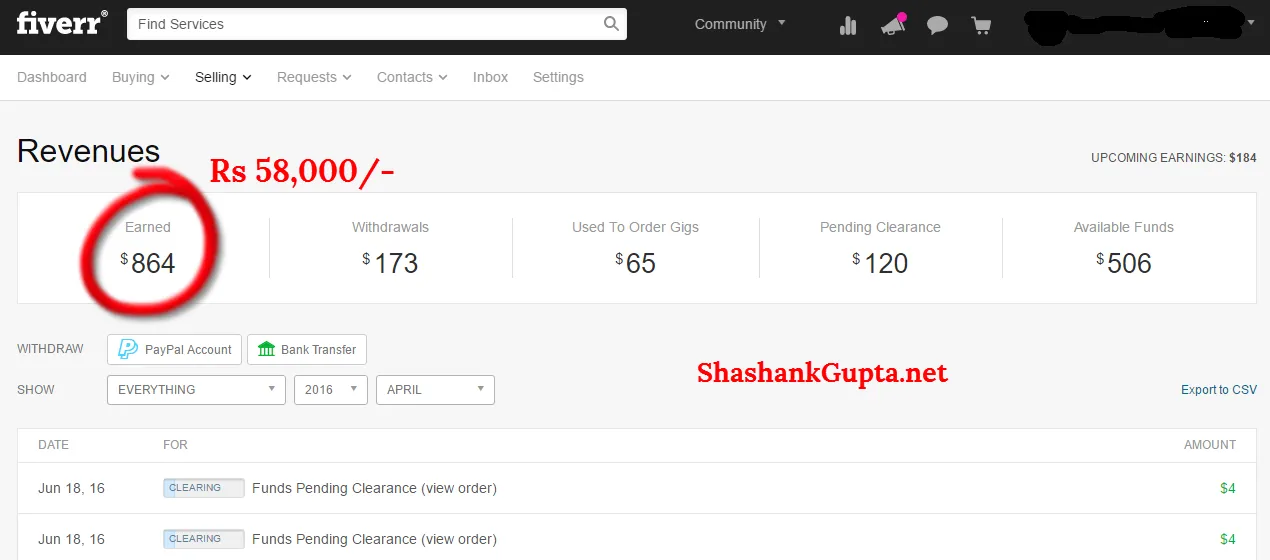Ever wondered how platforms like Fiverr thrive in the bustling gig economy? With thousands of jobs available from freelancers all over the world, it's intriguing to explore whether Fiverr itself is turning a profit. In this blog post, we'll break it down, exploring the revenue streams and business model that keep Fiverr running smoothly.
Overview of Fiverr's Business Model

Fiverr operates on a marketplace model that connects freelancers with clients seeking various services. Here’s how it works:
1. Service Offerings
- Fiverr allows freelancers to offer a wide range of services, known as "gigs". These can range from graphic design and writing to programming and digital marketing.
- Sellers can set their starting prices at $5, but they also have the option to offer different packages at higher price points, depending on the complexity and scope of the work.
2. Transaction Fees
Here’s where Fiverr makes its money:
| Transaction Type | Fee Charged |
|---|---|
| Sellers' Earnings | Fiverr takes a 20% commission from each completed order. |
| Buyers' Payments | Buyers pay a service fee on top of the gig price, typically around $2 for orders under $40. |
3. Subscription Services
In addition to the transaction fees, Fiverr has introduced subscription models for businesses called "Fiverr Business." This allows companies to access a curated pool of freelancers. This revenue model appeals to larger businesses looking for reliable freelancer partnerships, ensuring consistent income for Fiverr.
In summary, Fiverr's business model is a blend of connecting sellers and buyers, leveraging transaction fees, and expanding into subscription services. It’s a savvy way to monetize the freelance economy while creating opportunities for all involved!
Also Read This: Does Fiverr Have Scammers? Understanding the Risks and How to Stay Safe
3. Revenue Streams for Fiverr

Fiverr has constructed a multifaceted business model that allows it to generate revenue in several impactful ways. Understanding these revenue streams not only sheds light on how the platform operates but also highlights its strategic approach to maintaining a profitable ecosystem. Here’s a breakdown of Fiverr’s primary revenue sources:
- Service Fees: Fiverr charges a service fee on every transaction. For example, when a freelancer completes a gig, Fiverr takes a percentage of the total fee. Typically, this fee ranges from 5% to 20%, depending on the price of the service offered.
- Pro Services: Fiverr Pro is a premium section of the platform where top-tier freelancers can showcase their skills. Fiverr charges a higher service fee for these gigs, which reflects the enhanced quality and experience of the freelancers involved.
- Fiverr Learn: Offering online courses taught by industry experts, Fiverr Learn provides an additional revenue stream. These courses help freelancers enhance their skills, and Fiverr earns from course sales.
- Fiverr Business: This service targets companies looking for freelance talent by providing a curated selection of freelancers. Businesses are charged a subscription fee, allowing Fiverr to establish a consistent revenue model.
- Advertisements: Fiverr also generates money through ads. They promote their services across various channels, driving traffic and increasing user engagement, which boosts overall revenue.
These revenue streams together create a robust financial framework for Fiverr, allowing the platform to operate smoothly while continually attracting new freelancers and clients.
Also Read This: How to See What People Are Searching Up on Fiverr
4. How Fiverr Attracts Freelancers and Clients
Fiverr’s success hinges not only on its diverse revenue streams but also on its strategic marketing and community-building efforts. Attracting both freelancers and clients is a delicate balancing act, and Fiverr seems to manage it well. Here’s how they do it:
- User-Friendly Platform: Fiverr's straightforward interface makes it easy for new freelancers to create profiles and list their services. This simplicity encourages more people to join.
- Strong Branding: Fiverr's branding emphasizes creativity and flexibility, appealing to freelancers who want more control over their careers. Their slogan “Freelance Services for the Lean Entrepreneur” resonates well with those looking for freelance gigs.
- Diverse Categories: Offering a wide range of service categories—from graphic design to programming—means there’s something for everyone. This diversity attracts both specialized freelancers and clients with varying needs.
- Marketing Strategies: Fiverr invests in online marketing strategies including social media campaigns, Google Ads, and influencer partnerships to reach a broader audience. This effort helps them connect with potential clients who may benefit from hiring freelancers.
- Community Engagement: Fiverr actively engages its community through forums, webinars, and events. This fosters a sense of belonging and encourages freelancers to share their experiences, ultimately attracting new talent to the platform.
By combining these strategies, Fiverr successfully draws both freelancers looking for work and clients seeking quality services, creating a vibrant marketplace that benefits everyone involved.
Also Read This: What Are the Best Selling Gigs on Fiverr?
Market Competition and Fiverr's Position
When discussing Fiverr, it’s essential to understand the market competition and where Fiverr stands in this vast digital landscape. Fiverr operates in a crowded arena filled with various freelance platforms like Upwork, Freelancer, and PeoplePerHour. Each of these platforms has its unique characteristics, creating a rich mosaic for users to choose from. But what sets Fiverr apart?
One of Fiverr's standout features is its user-friendly interface. Unlike some platforms that require more effort in navigating or bidding, Fiverr offers a clean and intuitive experience where sellers list their services, or "gigs," at set prices. This fixed pricing model often simplifies decision-making for buyers, providing clarity and reducing the time spent on negotiations.
Here are some key points regarding Fiverr's position in the market:
- Diverse Service Offerings: Fiverr hosts a vast range of services, from graphic design to digital marketing, programming, and more, attracting a diverse clientele.
- Global Reach: It connects freelancers and clients from around the world, benefiting from a global talent pool and diverse customer base.
- Brand Recognition: Fiverr has successfully built a solid brand presence, often associated with affordable and creative solutions, which gives it a competitive edge.
However, competition does mean that Fiverr must continuously innovate. With competitors constantly improving their offerings, Fiverr stays competitive by adding new features, ensuring robust customer support, and emphasizing user satisfaction. Its position is strong, but it’s essential for Fiverr to keep adapting to maintain its leading edge.
Also Read This: Top 10 Financial Reports Translators on Fiverr
Success Stories: Examples of Profitable Users
Fiverr has become a launchpad for many freelancers who have successfully transformed their skills into sustainable incomes. Let’s dive into some inspiring success stories that showcase how users from different backgrounds have turned Fiverr into a thriving business.
1. *Graphic Designer: One Fiverr user started by offering simple logo designs for $5. Over time, as her skill improved and her portfolio grew, she increased her prices and began offering comprehensive branding packages. Today, she earns over $1,000 monthly from her Fiverr gigs, working just a few hours a week.
2. Copywriter: A former corporate professional shifted to freelance writing, posting gigs on Fiverr focused on creating compelling product descriptions and marketing content. Within a year, she secured ongoing contracts with multiple businesses and now earns around $2,500 a month. Her secret? Providing excellent customer service and gathering stellar reviews.
3. Web Developer*: A self-taught web developer leveraged Fiverr to build a clientele by offering responsive website designs. He started by charging low rates to gain reviews but soon established a reputation for quality work. Now, he charges upwards of $100 per project and has a steady stream of clientele, allowing him to leave his day job and commit to freelance work full-time.
These success stories illustrate not just the earning potential on Fiverr but also the importance of adaptability and continuous improvement. Each user identified their niche, took advantage of the platform, and made it work for them, empowering their freelance careers and personal growth. Fiverr isn’t just a platform; it’s a gateway to unlimited possibilities!
Also Read This: What Are the Qualifications for Fiverr Pro?
7. Challenges Faced by Fiverr
While Fiverr has revolutionized the way freelancers connect with clients, it's not all smooth sailing. Just like any platform, it faces several challenges that can impact its overall success and user satisfaction. Let's dive into some of these hurdles:
- Competition: The gig economy is bustling, with platforms like Upwork, Freelancer, and even social media marketplaces vying for the same users. This intense competition means Fiverr must continuously innovate to retain both freelancers and clients.
- Quality Control: With so many gigs available, maintaining a consistent quality of services can be tricky. Some buyers end up dissatisfied with their purchases, leading to negative reviews that can hurt a seller's reputation and diminish the platform's overall credibility.
- Fee Structures: Fiverr takes a commission from every sale, which can be frustrating for freelancers. As they try to maximize their profits, they sometimes feel constrained by the platform's fee model, leading to dissatisfaction among some sellers.
- Scams and Misinformation: As with any online marketplace, Fiverr occasionally falls victim to scams, where sellers might misrepresent their offerings, or clients might issue unwarranted chargebacks. This can result in a toxic user experience.
- Market Saturation: As more freelancers join the platform, it can become increasingly difficult for newcomers to stand out. This oversaturation can lead to reduced prices and lower overall earnings for existing sellers.
Also Read This: Can I Come Back to Making a Gig Layer on Fiverr?
8. Future Prospects: Is Fiverr's Revenue Growing?
Looking ahead, Fiverr's future seems promising, but how are they faring in terms of revenue growth? Let’s break it down:
Fiverr has consistently shown a trend of increasing revenue since its inception. This growth is primarily driven by:
- Expansion of Services: Fiverr continually adds new categories and services, which attracts a more diverse pool of freelancers and clients. This means more gigs and more potential for revenue!
- Global Reach: With its platform available in multiple countries, Fiverr is tapping into emerging markets. As internet accessibility expands worldwide, so does Fiverr’s potential user base.
- Investment in Marketing: Fiverr has been ramping up its marketing efforts, making significant investments in advertising. This helps in increasing brand visibility and attracting more users.
- Adopting New Technologies: The platform is also integrating advanced technologies such as AI to streamline the user experience. By automating certain processes, they can enhance efficiency and drive growth.
According to recent financial reports, Fiverr has seen year-on-year revenue growth. However, the challenges it faces must also be addressed for sustained success. Nonetheless, with its innovative strategies and a robust marketplace, Fiverr seems poised to continue its upward trajectory in the gig economy.
Does Fiverr Make Money?
Fiverr is a leading online marketplace that connects freelancers with clients looking for various services. Founded in 2010, Fiverr allows users to offer services ranging from graphic design to content writing, programming, and digital marketing. The platform operates under a unique business model that raises the question: Does Fiverr really make money?
To understand Fiverr's revenue generation, we need to explore their business model:
- Service Fees: Fiverr charges freelancers a service fee of 20% on each transaction. This means that for every $100 earned by a freelancer, Fiverr takes $20.
- Buyer Fees: In addition to service fees, Fiverr also charges buyers a processing fee, which typically ranges from $2 to $5 based on the order size.
- Pro Services: Fiverr offers a selection of Pro services where vetted freelancers can charge premium prices. Fiverr takes a commission from these transactions as well.
Fiverr also invests in marketing and user experience to grow its user base, with over 3 million active buyers and thousands of sellers worldwide. The combination of these revenue streams enhances Fiverr's profitability.
| Revenue Stream | Description |
|---|---|
| Service Fees | 20% of freelancer earnings |
| Buyer Fees | Processing fees based on order size |
| Pro Services | Commission from premium services |
In conclusion, Fiverr makes money through a multi-faceted revenue model that combines service fees, buyer fees, and premium services. This approach not only provides income for the platform but also incentivizes freelancers and maintains a thriving marketplace.



